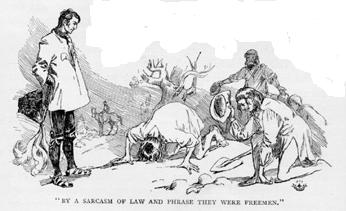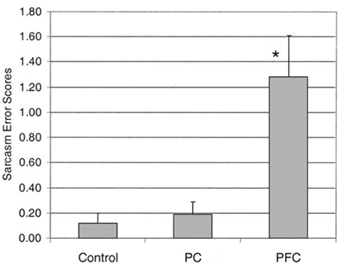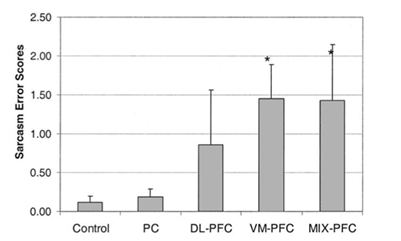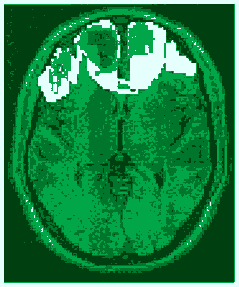« Sad news | Main | Brunswik Society »
June 13, 2005
Anybody got any sarcasm?
THE NEUROANATOMICAL BASIS OF UNDERSTANDING SARCASM AND ITS RELATIONSHIP TO SOCIAL COGNITION:

Detecting sarcasm relies upon the ability to monitor other peoples' mental states, thoughts and feelings. Detecting sarcasm then is necessary for effective decision making and social cognition. A recent article in Neuropsychology offers findings regarding the neurobiology of comprehension of sarcasm and the cognitive processes underlying it.
ABSRTACT:
"The authors explored the neurobiology of sarcasm and the cognitive processes underlying it by examining the performance of participants with focal lesions on tasks that required understanding of sarcasm and social cognition. Participants with prefrontal damage (n 25) showed impaired performance on the sarcasm task, whereas participants with posterior damage (n 16) and healthy controls (n 17) performed the same task without difficulty. Within the prefrontal group, right ventromedial lesions were associated with the most profound deficit in comprehending sarcasm. In addition, although the prefrontal damage was associated with deficits in theory of mind and right hemisphere damage was associated with deficits in identifying emotions, these 2 abilities were related to the ability to understand sarcasm. This suggests that the right frontal lobe mediates understanding of sarcasm by integrating affective processing with perspective taking."
QUOTES:
"Irony is an indirect form of speech used to convey feelings in an indirect way. Ironic utterances are characterized by opposition between the literal meaning of the sentence and the speaker’s meaning (Winner, 1988). One form of irony is sarcasm. Sarcasm is usually used to communicate implicit criticism about the listener or the situation. It is usually used in situations provoking negative affect and is accompanied by disapproval, contempt, and scorn (Sperber & Wilson, 1986). For example, a boss catching his employee taking a nap may remark “Joe, don’t work too hard!” to express his disapproval. The listener must identify the opposition between the literal meaning of this sentence (Joe is working too hard) and the boss’s intention to criticize Joe (Joe is a lazy worker). The ironic speaker intends that the listener detect the deliberate falseness; he makes a statement that violates the context and intends the listener to recognize this statement (Dennis, Purvis, Barnes, Wilkinson, & Winner, 2001). The interpretation of sarcasm thus involves understanding of the intentions expressed in the situation and may include processes of social cognition and theory of mind."
"It appears that a deficit in understanding sarcastic utterances may reflect an impaired ability to understand social cues such as intentions, beliefs, and emotions. In concordance, recent theories explaining irony have argued that sarcastic comments are interpreted in the light of their relevance to the situation. Sperber and Wilson’s (1981) relevance theory advocates that the interpretation of ironic utterances may require recognition of the speaker’s attitude and thus requires shared knowledge between the speaker and the listener."
"Although the right hemisphere is clearly implicated in detection of irony and sarcasm, there are indications that the frontal lobes may also be involved in interpretation of sarcastic utterances. The frontal lobes have long been considered to play a special role in social cognition, with damage in this region affecting not only high-level cognitive functions but also social behavior (Adolphs, 1999; Eslinger, 1998) and personality (A. R. Damasio, 1994). Alexander, Benson, and Stuss (1989) suggested that damage to the frontal lobes area may impair analysis, planning, and monitoring of language."
"The social communicative function of irony suggests a distinct role for ventromedial (VM) regions within the frontal lobes, as opposed to dorsolateral (DL) regions. Whereas DL prefrontal regions have been associated with executive functions, VM lesions have been shown to result in impaired social skills, such as social judgment (Eslinger & Damasio, 1985) and decision making (Bechara, Damasio, Tranel, & Anderson, 1998). Thus, if patients with lesions in sub-regions of the prefrontal cortex differ in their deficit in understanding sarcasm, this would suggest that specific areas within the prefrontal cortex are crucial to the mediation of comprehension of sarcastic utterances."
"Given the emotional and social communicative function of sarcastic utterances, it is only to be expected that its interpretation would be mediated by brain areas specialized in affective processing and social cognition. As noted above, the right frontal lobe has been implicated in nonliteral language functions (Alexander et al., 1989), humor appreciation (Shammi & Stuss, 1999), and self-awareness (Stuss & Benson, 1986). It has been previously suggested that the right and the left hemispheres have separate contributions to communication, the left hemisphere’s role being propositional and symbolic and the right hemisphere’s role being emotional (Bloom, Borod, Obler, & Gerstman, 1993; Buck, 1995)."

"Mean sarcasm error scores (error bars represent standard error) in patients with posterior (PC) and prefrontal (PFC) lesions and in healthy controls. Post hoc analysis: PFC was significantly different from healthy controls and PC (*p<.05)."

"Mean sarcasm error scores (error bars represent standard error) in patients with lesions limited to subregions of the prefrontal cortex (PFC), compared with posterior cortex (PC) lesion patients and healthy controls (*p<.05). VM=ventromedial PFC; DL=dorsolateral PFC; MIX=mixed DL and VM lesions."

"Lesions associated with impaired ability to interpret sarcasm. Reconstruction of the prefrontal cortex lesions in 13 patients with the most impaired sarcasm scores. Superimposition of lesions indicated that in this group, the lesion in the right ventromedial area was significantly larger than the lesions in either the left ventromedial or right dorsolateral regions (but not significantly different from the left dorsolateral). Note that in the picture, as in imaging scans, left is right."
"The present study offers findings regarding the neurobiology of comprehension of sarcasm and the cognitive processes underlying it. First, in the task that assesses understanding of sarcastic utterances, participants with prefrontal damage showed impaired performance, whereas participants with posterior damage and HCs showed a preserved performance. Within the frontal lobe group, right prefrontal damage, and particularly damage incorporating the right VM region, was associated with the most profound deficit in understanding sarcasm. Second, although prefrontal damage was associated with deficits in ToM and right hemisphere damage was associated with deficits in the ability to identify emotions, both abilities were related to the ability to understand sarcastic utterances."
ABOUT THE AUTHORS:
S. G. Shamay-Tsoory is Faculty at the University of Haifa, Israel. Her research interests include: Neural correlates of emotions and social cognition, particularly empathy and "theory of mind", the behavioral and emotional consequences of brain injury, developmental neuropsychology and the neuropsychological basis of autism - from departmental page.
Rachel Tomer is Senior lecturer in the department of psychology and head of the Clinical Neuropsychology Program at Haifa University, Israel. "My major interest is the behavioural correlates of normal and pathological asymmetries in the brain. My focus is on the subcortical-prefrontal circuits, which are affected in a number of neuropsychiatric syndromes, and more specifically on the role of asymmetries (functional as well as structural) in these pathologies. Current studies involve cognitive and affective changes in Parkinson’s disease, Obsessive-Compulsive Disease and acquired brain damage, and how these are related to abnormal patterns of asymmetry in the brain." - from Tomer's Homepage.
Judith Aharon-Peretz is Faculty Cognitive Neurology Unit, Rambam Medical Center, Israel. Her research interests include: Cognitive flexibility in Parkinson’s disease: the contribution of clinical characteristics to impairment in spontaneous vs. Reactive flexibility. Aharon-Peretz page at The Technion-Israel Institute of technology.
Posted by DSN at June 13, 2005 10:34 PM